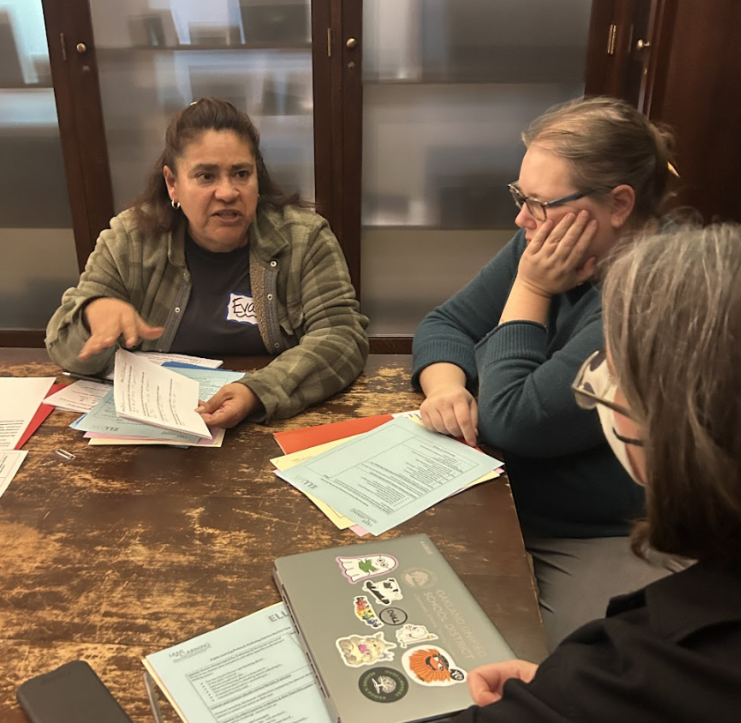
Empowering Educators: Building Efficacy Through Learning Conversations and Supportive Challenge – A Collaborative Research Project Between Lead by Learning, Mills College at Northeastern University, and OUSD ELLMA
If you have worked with Lead by Learning before, you’ll be familiar with the particular flow of our sessions. We provide participants opportunities to think alone and together about a problem of practice connected to their collective vision or goal for student learning. Core to these sensemaking conversations are opportunities for Learners to share their messy dilemmas and for Listeners to respond with reflections and questions that help the Learner probe deeper into what they’re actually seeking and their next steps.
We call these conversations “Learning Conversations” as they provide space for participants to express uncertainty, seek clarity through examining data, identify goals, and generate next steps. Through these conversations, our listening partners help to raise questions or notice facets of our conundrums that we can’t see on our own. We call this type of partnership Supportive Challenge, as it offers targeted observations and questions that deepen a colleague’s thinking while also caring for their learning and the success of their students.
This year Lead by Learning is engaging in a research partnership with Oakland Unified’s English Language Learners and Multilingual Achievement (ELLMA) Office and Jaci Urbani, Professor of Education at Mills College at Northeastern University, to study how educators build collective efficacy for anti-racism so that they feel agentic in supporting positive educational outcomes for historically marginalized students. Through this research, we’ve identified some of the ways that these types of Supportively Challenging conversations build efficacy for teachers, specifically helping them to clarify their goals and validate their positive impact using specific instructional practices to meet students’ needs.
So what does this look like in practice?
Multilingual students are traditionally marginalized in schools due to age, immigrant status, language ability, and race. Knowing this, the ELLMA teachers’ shared goal is to honor and encourage student voice while also supporting their English language development. The complexity of this goal means that teachers are often unclear around what to prioritize. Learning Conversations and Supportive Challenge from colleagues helps them validate or understand how to adjust their instructional decisions.
During one Learning Conversation, a trio of educators sat across from each other sharing student writing samples. Patricia asked Julia: “I want to know, what were you really wanting to see?” At first, Julia wasn’t quite sure. She wanted strong topic sentences and detailed paragraphs that followed but also felt conflicted about how much to scaffold her students’ work, risking losing their voice in the process. Patricia asked a Supportively Challenging question, “And how do you balance who needs what scaffolds and when?” As Julia’s peers listened to her grappling, they went back and forth, reflecting back what they heard and eventually helping Julia identify her goals– one topic sentence followed by three detail sentences. In the process of engaging together, they helped Julia feel more confident about her decision to scaffold the paragraphs. Sometimes the goal is about internalizing a structure more than allowing space for creativity in student voice… and that’s okay!
Patricia then described her own feelings of uncertainty. What was the most relevant language structure to focus on with her12th-grade newcomers in an applied psychology class? For instance, was “versus” a ubiquitous enough writing strategy to be worth learning above all other language moves? As Patricia referenced her lesson plan and responded to questions about what felt most important to leverage, she decided that indeed, comparative language WAS a useful area of focus for this unit. She breathed a sigh of relief with her newfound clarity:
I guess I just don’t have to worry about some of these other things. Just focus on that. Okay… good…thank you.
Julia and Patricia both led with their vulnerability and engaged in critical dialogue with their colleagues. They expressed uncertainty about their goals, the quality and effectiveness of their instruction, and whether students had internalized the structures they sought to teach.
Another teacher, Alyce, shared a similar concern: she questioned how to be clear on her expectations with students, specifically with structure for claims and evidence within opinion writing, without taking away their voice in the text. Throughout the year, she had provided sentence starters and visual frames. Towards the end of the year, she wanted to ask for a written product without explicitly encouraging the use of these scaffolds; she wanted to see if students had internalized those supports.
Alyce shared that when students had not relied on those supports for the first draft, she assisted them with the second by explicitly relying upon the previously taught scaffolds . However, she noticed that the first draft had more of their own voice and was then questioning herself about having taken that away in the second. After sharing the drafts with the group of teachers, one commented, “You’re questioning whether your students are successful based on your instruction – and they were! You didn’t have to be explicit about using the scaffolds because they were implementing them in their writing. They were able to provide the facts and evidence you were looking for. Look at their first drafts again, they did it. You were successful!”
Good teachers question their efficacy, look at student data for guidance, and invite thought partnership from colleagues. In each case above, through conversation and looking at student writing, teachers found clarity around prioritizing their language instruction which generated next steps, sometimes providing more structure and sometimes providing less scaffolding to let students’ voices shine.
